




 St Martin, Bowness-on-Windermere
St Martin, Bowness-on-Windermere
CCB78.jpg Stained glass; St Michael, St George and the Dragon, St Gabriel, by Powell, Whitefriars; memorial to John Reginald Lingard, died Gallipoli, World War I, 1915.
(taken 12.11.2014)

BRL55.jpg Stained glass; coat of arms, Lt John Reginald Lingard, d.1915.
(taken 18.9.2009)
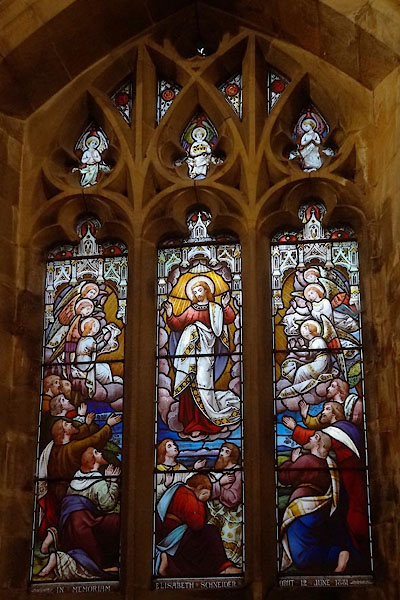
CCB79.jpg Stained glass; the Ascension, by Ward and Hughes, 1881.
(taken 12.11.2014)
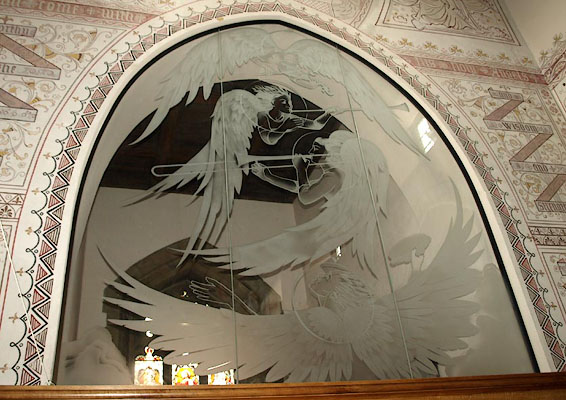
BRL38.jpg Engraved glass; angels with musical instruments.
(taken 18.9.2009)
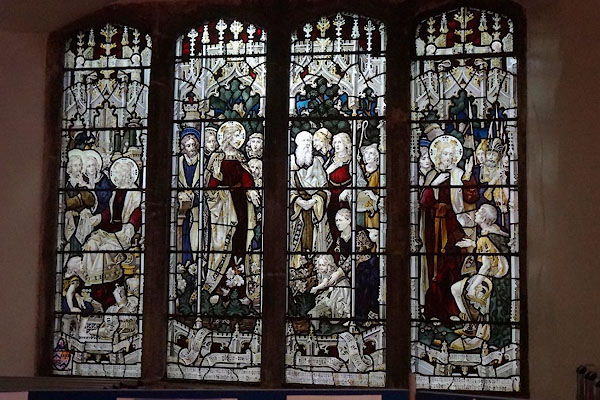
CCB81.jpg Stained glass; Christ preaching, Christ healing the centurion's servant, by Ward and Hughes, about 1894.
(taken 12.11.2014)
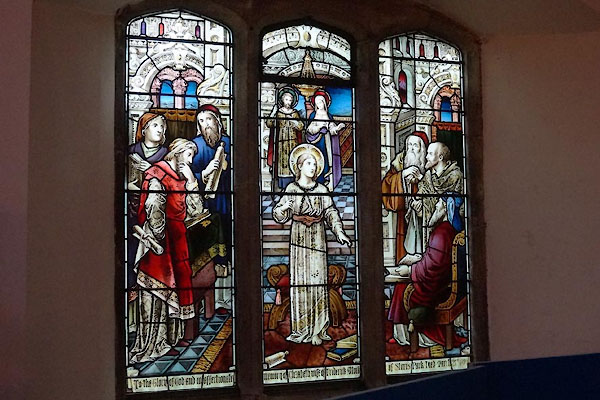
CCB82.jpg Stained glass; Christ disputing with the Elders, by A L Moore, about 1899.
(taken 12.11.2014)

CCB83.jpg Stained glass; Acts of Charity, by Ward and Hughes, 1895.
(taken 12.11.2014)
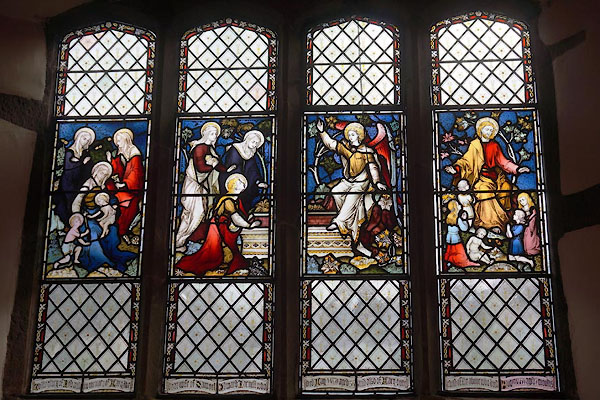
CCB84.jpg Stained glass; Christ and John the Baptist, the Empty Tomb, Christ with little children, by John Hardman, about 1871.
(taken 12.11.2014)
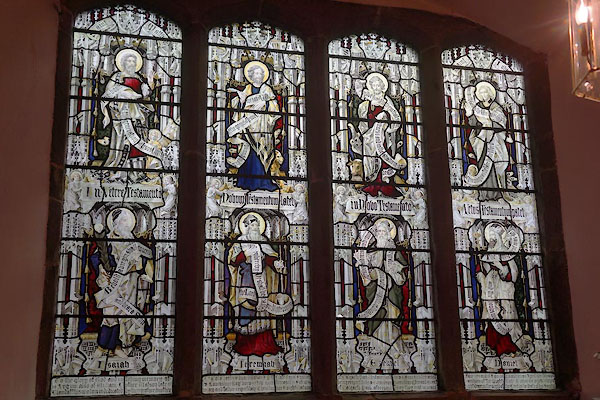
CCB85.jpg Stained glass; St Matthew, St Mark, St Luke, St John, Isaiah, Jeremiah, Ezekiel, Daniel, by T F Curtis, Ward and Hughes, 1897.
(taken 12.11.2014)
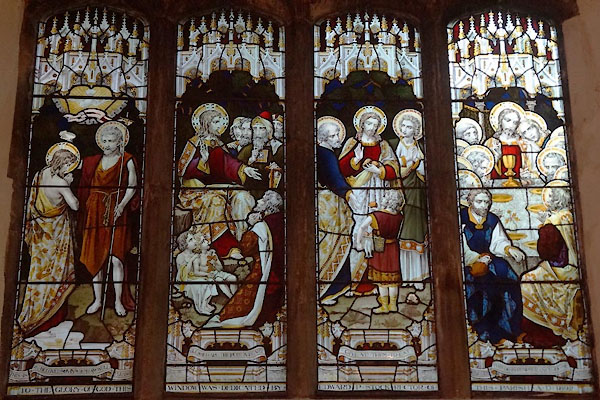
CCB86.jpg Stained glass.; Baptism of Christ, Christ preaching, Feeding the five thousand, the Last Supper, by Ward and Hughes, 1892.
(taken 12.11.2014)
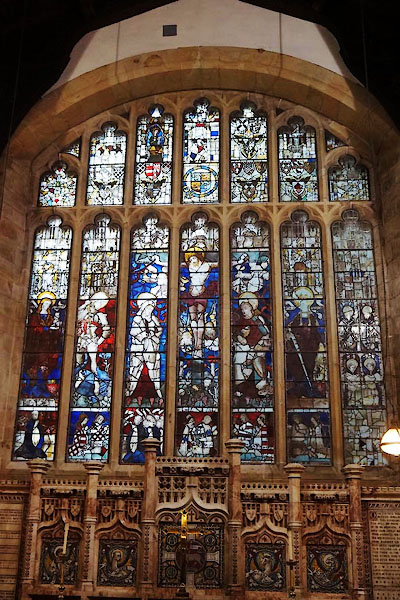
CCB87.jpg Stained glass, east window; the Crucifixion.
(taken 12.11.2014)
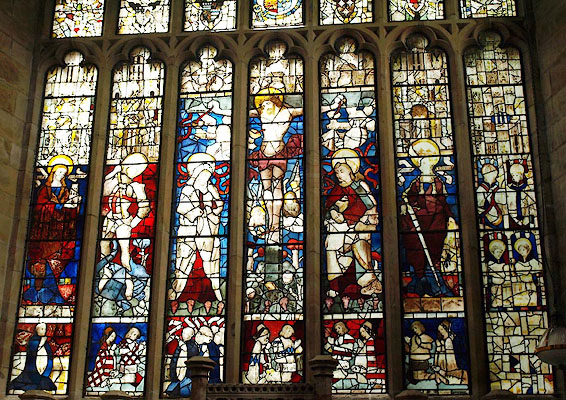
BRL42.jpg Stained glass, east window; the Crucifixion.
(taken 18.9.2009)
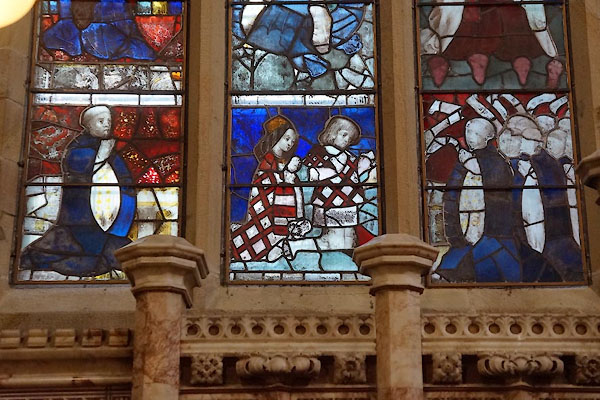
CCB88.jpg Stained glass, east window; detail.
(taken 12.11.2014)
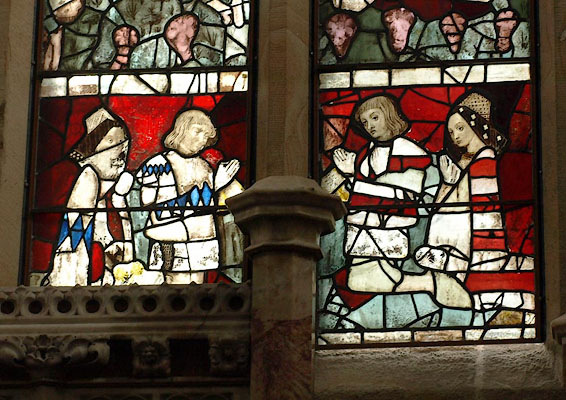
BRL43.jpg Stained glass, east window; detail.
(taken 18.9.2009)
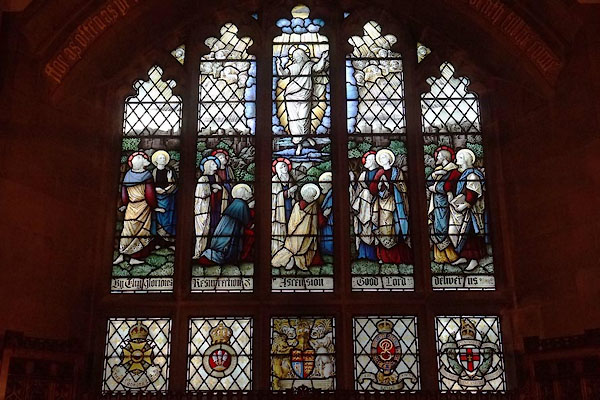
CCB90.jpg Stained glass; the Ascension, by Ward and Hughes, 1881.
(taken 12.11.2014)
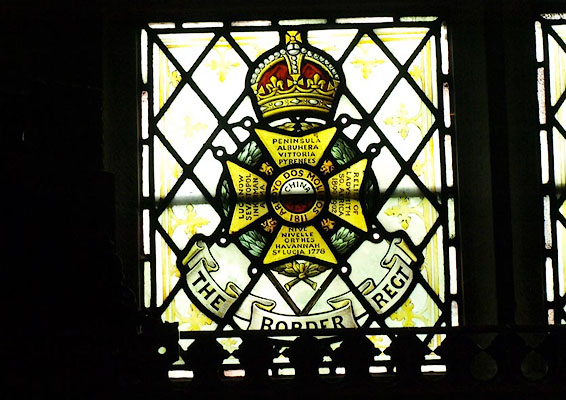
BRL46.jpg Stained glass; badge of The Border Regiment.
(taken 18.9.2009)

BRL47.jpg Stained glass; badge of the Westmorland and Cumberland Yeomanry.
(taken 18.9.2009)

BRL48.jpg Stained glass; badge of the King's Own Regiment.
(taken 18.9.2009)
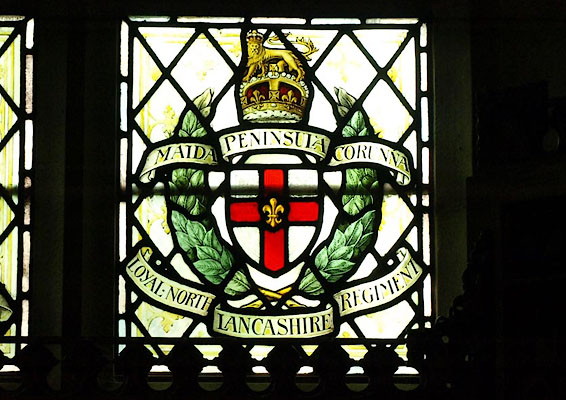
BRL49.jpg Stained glass; badge of the Loyal North Lancashire Regiment.
(taken 18.9.2009)
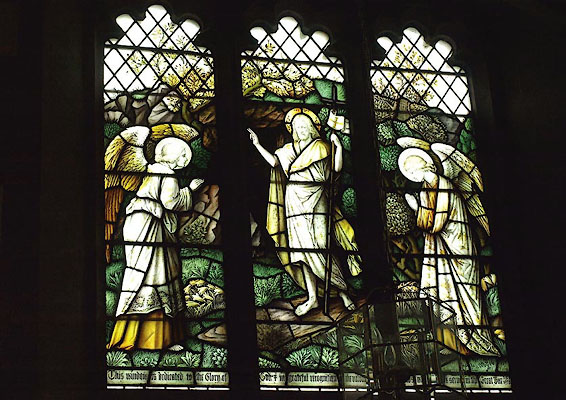
BRL45.jpg Stained glass; the Resurrection, by Shrigley and Hunt; war memorial, World War I, 1914-18.
(taken 18.9.2009)

CCB92.jpg Stained glass; the sower, Christ the Good Shepherd, Feed my Lambs, by Henry Hughes, 1877.
(taken 12.11.2014)

CCB93.jpg Stained glass; Christ in Majesty or Te Deum window, by Burlison and Grylls, about 1906.
(taken 12.11.2014)
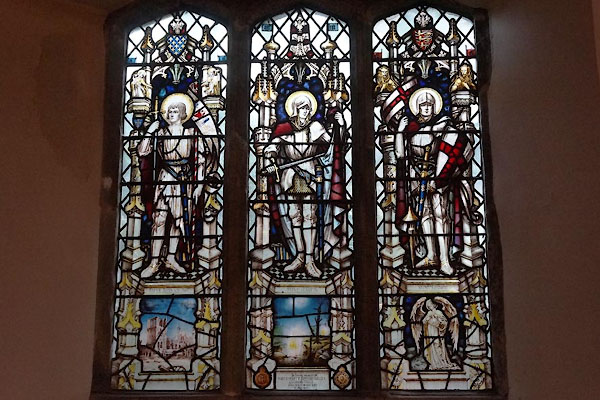
CCB94.jpg Stained glass; St Joan, St Mark, St George, by A K Nicholson, about 1915.
(taken 12.11.2014)
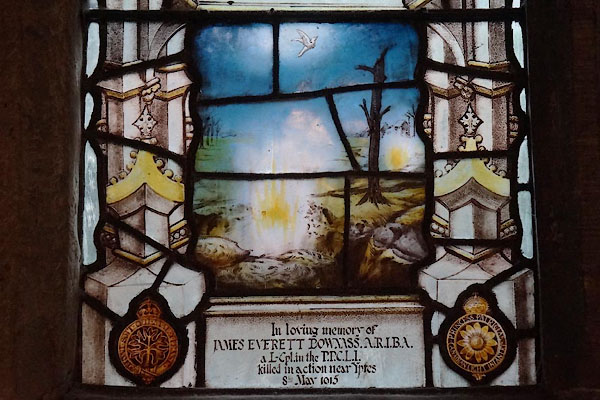
CCB95.jpg Stained glass; detail, battlefield near Ypres; memorial to LCpl James Everett Bownass, killed in World War I, 1915.
(taken 12.11.2014)
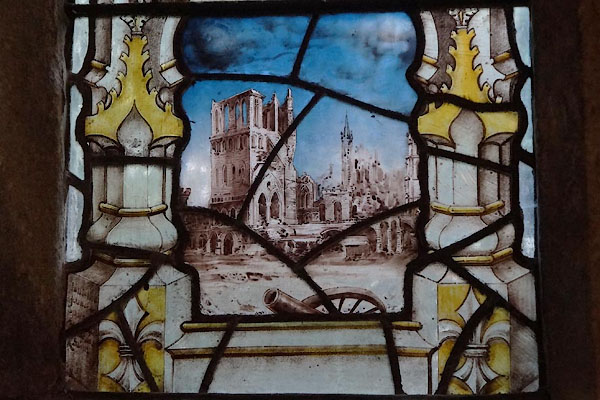
CCB96.jpg Stained glass; detail, ruined cathedral, France, World War I.
(taken 12.11.2014)
item:- stained glass
 goto source
goto sourceGentleman's Magazine 1849 part 2 p.587 "[St Martin, Bowness-on-Windermere] ..."
"The pride of our church is, or rather was, the gorgeous east window, which yet retains abundant though sorely mutilated remains of the stained glass with which it was superbly filled. It is said that this interesting specimen of ancienrt decoration formerly belonged to the abbey of Saint Mary in Furness, and that after the destruction of that celebrated institution in A.D. 1537 it was purchased by the parishioners of Windermere, and removed hither. In 1775, when Mr West wrote, this noble window was much more perfect, as the following description, taken from his "Antiquities of Furness," will testify:-"
""The east window of the church of Furness Abbey has been noble; some of the painted glass that once adorned it is preserved in a window in Windermere church. The window in that church consists of seven compartments, or partitions. In the third, fourth, and fifth are depicted in full proportion the Crucifixion, with the Virgin Mary on the right, and the beloved disciple St. John the Evangelist on the left side of the cross. Angels are expressed receiving the sacred blood from the five precious wounds. Below the cross are a group of monks in the proper habits, with the abbot in a vestment. Their names are written on labels issuing from their mouths. The abbot's name is defaced, which would have given a date to the"
 goto source
goto sourceGentleman's Magazine 1849 part 2 p.588 "whole. In the second partition are the figures of St. George and the Dragon. In the sixth is represented St. Catharine with the emblems of her martyrdom, the sword and the wheel. In the seventh are two figues of the mitred abbots, and underneath them two monks dressed in vestments. In the middle compartment, above, are finely painted, quarterly, the arms of France and England, bound with garter and its motto, probably done in the reign of King Edward III. The rest of the window is filled up by pieces of tracery, with some figures in coats armorial, and the arms of several benefactors to the abbey, amongst whom are Lancaster, Urswick, Fleming, Harrington, Millum, Kirkley, Preston, and Middleton.""
"Such, until very lately, has been the generally received history of this lauded window. Its authenticity has, however, in some measure been recently called in question by the author of the highly erudite and interesting work on the history and antiquities of Furness Abbey, entitled "Annales Furnesienses,"*wherein, after describing the dimensions of the east window of the abbey church to have been 23 feet 6 inches in breadth, and 47 feet in height, proportions infinitely more imposing than those of the window in Windermere church, he questions the authority Mr. West may have had for his assertion that the stained glass was obtained from the abbey. "That part of it," says the author I quote, "may once have filled some of the windows is probable; but it is equally certain that other portions have been procured from Cartmel Priory, as the name of a prior and sub-prior, and the arms of that house, are yet discernible therein.""
"When first set up in Windermere church, it must have been a splendid fenestral embellishment, full of the finest effects, and worthy of either of the noble edifices from which it was removed, as several of the figures are as large as life, the colours very fine, and the drawing of the hands, feet, heads, and remaining parts very perfect. Since that time it has met with much rude treatment; the names of the monks, except those of William Hartley and Thomas Housen, are all effaced, and even so lately as the past year portions have been dashed in. Were it not, therefore, for the help afforded by the above description, but little of its former elegant composition and resplendent colouring could now be made out against the confused wreck of its magnificence, so strangely jumbled in chaotic assemblage with square and lozenge panes of plain uncoloured glass, and if the work of spoilation is permitted to continue without endeavour to prevent repetitions of such desecration, in a short time the account above cited will be all that will be left to shew that such a characteristic record of the pious feelings of bygone ages ever existed."
"In one of the windows in the north aisle are some significant devices - armorial they can scarcely be called - in painted glass, usually known as "the Carriers' Arms." They may be described as a rope and five packing-needles or, with a wantey hook gules, on a pane of uncoloured glass, such being the implements and materials used by carriers to fasten their packing sheets together. Near these industrial emblems, in the same window, but upon another pane, are representations of other instruments likewise used in the same business; and as the tradition current in the parish respecting this piece of emblazonry has reference to an incident in the history of the church, I am tempted to record it. When the church required to be rebuilt, together with the chapels of St. Mary Holme, Troutbeck, and Applethwaite, which had all been destroyed or rendered unfit fot divine worship, the parish was so extremely poor that the parishioners determined that one church should serve the whole. The next question was, where should it stand? The inhabitants of Undewnilbeck (sic) were for having it at Bowness, while others contended that as Troutbeck Bridge was about the centre of the parish it should be built there. Meetings were in consequence held, and many discussions arose; at last a carrier proposed that"
"*The author of this work was Thomas Alcock Beck, esq. He died in 1846, and is thus commemorated in a mural mounument in Hawkshead church, Lancashire:"
""Thomas Alcock Beck de Esthwaite Lodge in hac parochia, Arm. juxta borealem cemterii angulum tumulitus jacet, Qui Antiquitatum Indagator si quis aliius felicissimum Annales Furnesienses summa elegantia composuit. In ipso literarum cursu adhuc occupatus decessit XXIV. die Aprilis, an. Dom. MDCCCXLVI. aetat LI." - EDIT."
 goto source
goto sourceGentleman's Magazine 1849 part 2 p.589 "whoever would make the largest donation towards the building should choose the site. An offer so reasonable could hardly be refused, and many gifts were accordingly named. The carrier, who had amassed wealth by his business, heard them all, and then declared he would cover the cover the church with lead. This offer, which the rest were either unable or unwilling to outdo, at once decided the affair. The carrier therefore chose the old site, and his arms, or more properly some of the instruments of his trade, were, in accordance with the ancient custom of thus perpetuating the remembrance of benefactors, painted on one of the windows of the north aisle. Tradition adds that this man obtained the name of Bellman, from the circumstance of his having been the first to introduce the bells worn by the fore horse of a gang of pack horses; and the singularity of the church being covered with lead when all the others in the neighbourhood are covered with slate gives probability to the story."

BXW05.jpg Stained glass; Carrier's Arms:-
"THIS PIECE OF ANCIENT / GLASS KNOWN AS / 'THE CARRIERS ARMS' / WAS, ACCORDING TO TRADITION, / PLACED IN THIS CHURCH AS A / MEMORIAL TO THE CARRIER WHO / GAVE AND CONVEYED THE LEAD / ON PACK-HORSES GRATUITOUSLY / FOR THE ROOF IN REBUILDING / THE CHURCH IN THE EARLY / PART OF THE 16TH. CENTURY." (taken 15.2.2013)
